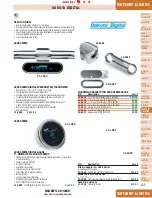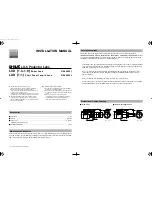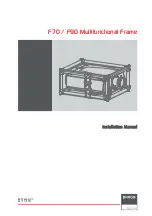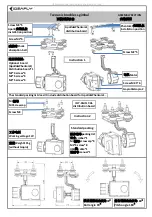
10
Subject to change without notice | 83059200dUK – Translation of the original operating manual | ait-deutschland GmbH
6 Electrical installation
6.1 Connect the electrical cables
ATTENTION
Irreparable damage to the compressor due to
wrong rotating field!
► Ensure that there is a clockwise rotating field for
the compressor load infeed.
Basic information on the electrical connection
● The specifications of the local energy supply
company may apply to electrical connections
●
Fit the power supply for the heat pump with an
all-pole circuit breaker with at least 3 mm contact
spacing (per IEC 60947-2)
●
Note the level of the tripping current
●
Comply with the electromagnetic compatibility
regulations (EMC regulations)
●
Lay unshielded power supply cables and shielded
cables (bus cable) sufficiently far apart (> 100 mm)
●
Maximum line length: 30m
Cable extension details see heat pump manual
Establish the electrical connections between
the heat pump and the hydraulic module
1. Route the two plug-in connections of the load and
bus cables from the hydraulic module to the plug-
in points on the heat pump.
NOTE.
For dual output-controlled heat pumps, the
lines (8 m) are already connected to the heat
pump.
2. Couple the connectors together:
3. Fit cover for plug-in connections.
6.2 Electrical connection
The electrical connection is established via the switch
box.
1.
Strip the sheathing off all cables to the external
loads before laying in the cable gland of the glands
box.
2. Feed the cable on the rear of the hydraulic module
through the cable gland in the switch box.
3. Open the switch box in the unit.
Only slightly undo the top two screws of the cover
plate. Remove the remaining screws. Unhook
cover panel.
4. Feed the control and sensor cable as well as
the cable for the EVU blocking time through the
glands on the rear of the unit and into interior
of the device. Lay the cables through the cable
gland to the terminals in the switch box.
5. Carry out electrical connections in accordance
with the terminal diagram.
“Terminal diagram” for the respective model, from
page 23
Example HV 9-1/3:
1 Connection, bus cable EVS/EVS8
2 Connection, load cable EVS/EVS8
3 Cable glands
4 Contactor
5 Control panel
6 Cable routing
7 Return flow sensor











































